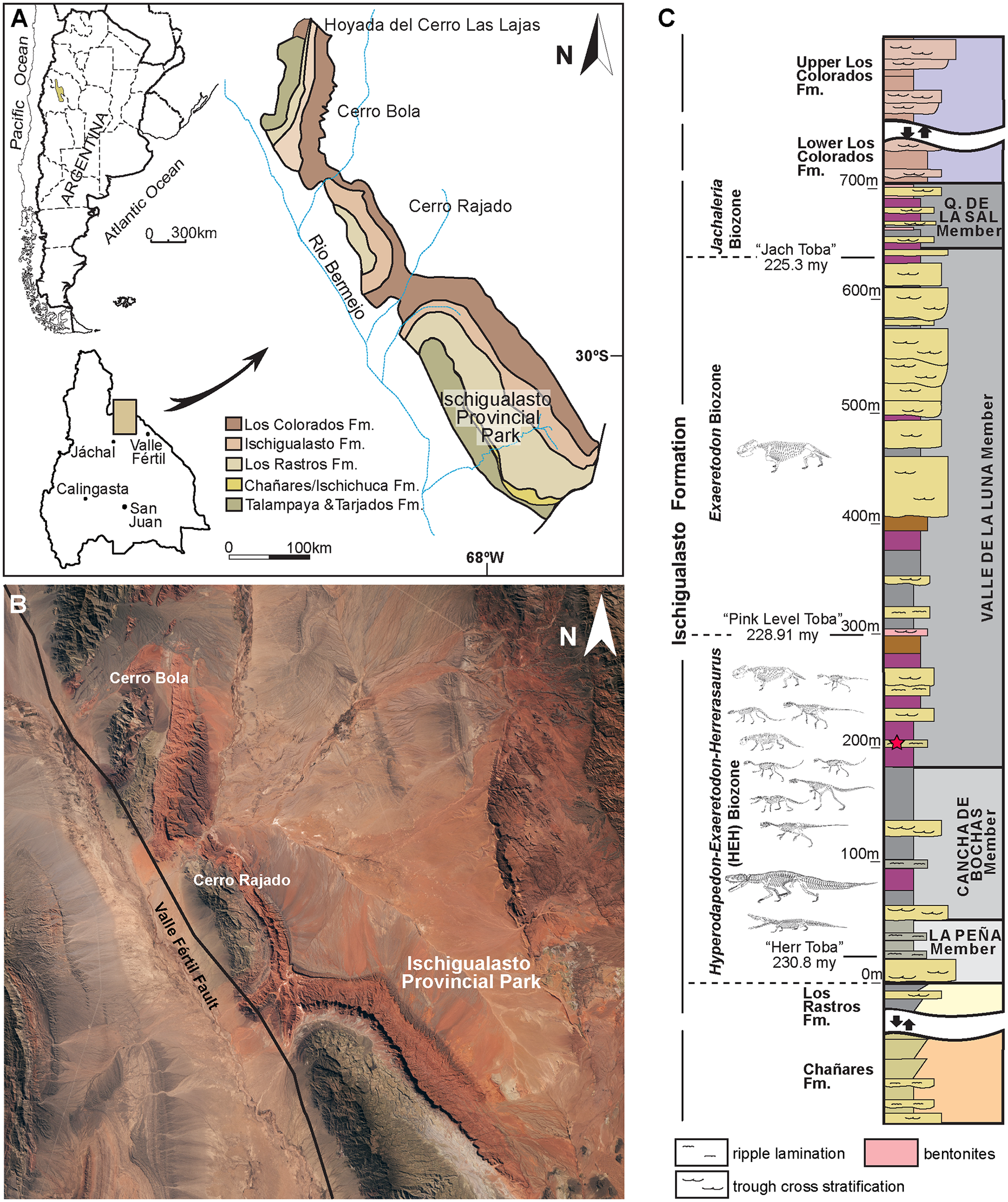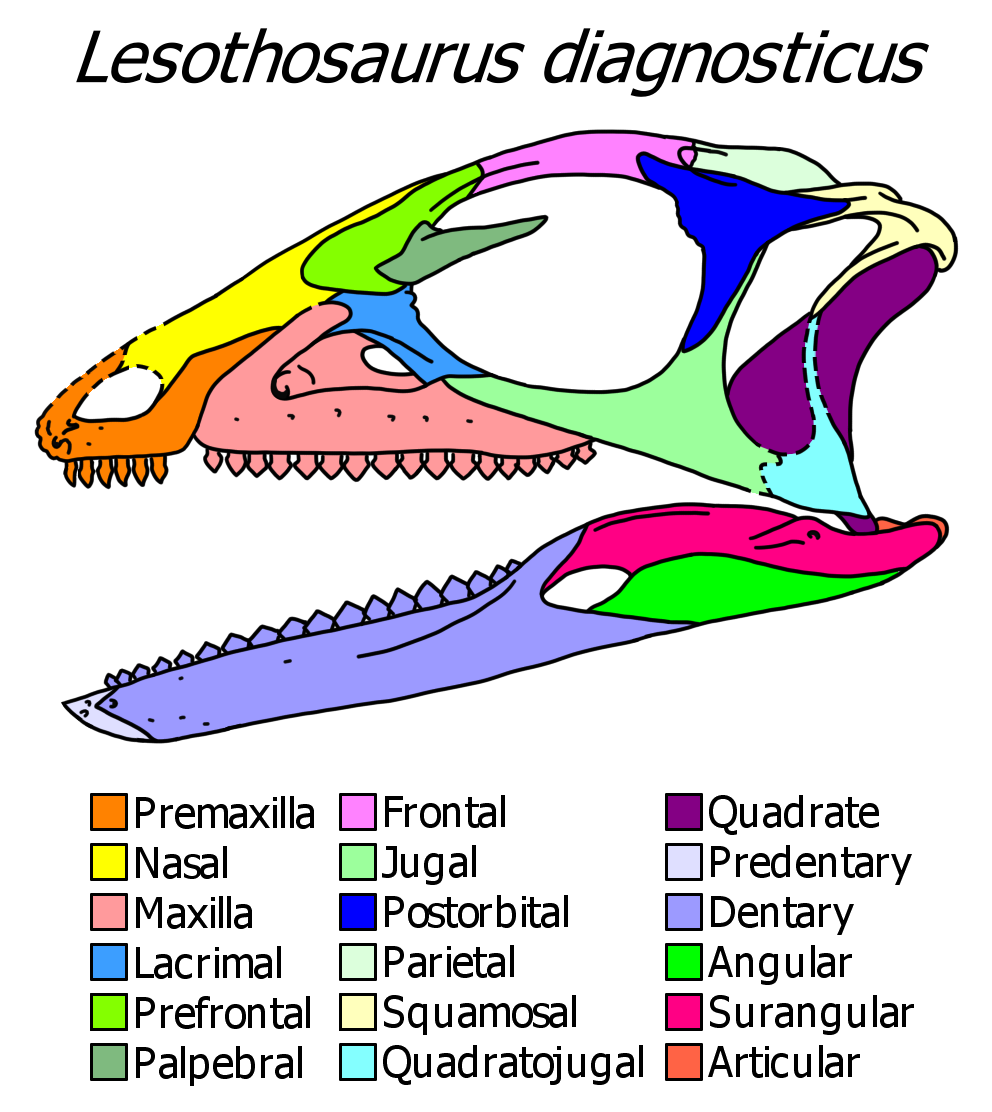|
Venaticosuchus
''Venaticosuchus'' is a genus of pseudosuchian archosaurs from the family Ornithosuchidae. Known from a single species, ''Venaticosuchus rusconii'', this genus is described based on an incomplete skull and jaw (as well as a lost partial forelimb and osteoderms) collected from the Late Triassic (Carnian) Ischigualasto Formation in the Ischigualasto-Villa Unión Basin in northwestern Argentina, which was deposited around 230 million years ago. This fossil material has been termed the holotype specimen PVL 2578. ''Venaticosuchus'' incorporated a myriad of features present in the other two genera of ornithosuchids, '' Ornithosuchus'' and '' Riojasuchus''. However, it also had several unique traits, relating to the lower jaw. Reconstructions of the jaw musculature of ''Venaticosuchus'' showed that it had a slow, strong bite, similar to those of herbivorous aetosaurs such as ''Desmatosuchus''. ''Venaticosuchus'' and other ornithosuchids were likely specialized scavengers, due to a ... [...More Info...] [...Related Items...] OR: [Wikipedia] [Google] [Baidu] |
Ornithosuchidae
Ornithosuchidae is an extinct family (biology), family of Pseudosuchia, pseudosuchian archosaurs (distant relatives of modern Crocodilia, crocodilians) from the Triassic period. Ornithosuchids were quadrupedal and facultatively bipedal (e.g. like Chimpanzee, chimpanzees), meaning that they had the ability to walk on two legs for short periods of time. They had distinctive, downturned snouts, unique, "crocodile-reversed" ankle bones, and several other features that distinguish them from other archosaurs. Ornithosuchids were geographically widespread during the Carnian and Norian stages of the Late Triassic with members known from Argentina, Brazil, and the United Kingdom. Four genera, comprising ''Ornithosuchus'', ''Venaticosuchus, Dynamosuchus,'' and ''Riojasuchus'' are presently known. The family was first erected by German paleontologist Friedrich von Huene in 1908. Description Skull Ornithosuchids can be identified by the presence of an arched Diastema (dentistry), diastem ... [...More Info...] [...Related Items...] OR: [Wikipedia] [Google] [Baidu] |
Ischigualasto Formation
The Ischigualasto Formation is a Late Triassic geological formation in the Ischigualasto-Villa Unión Basin of southwestern La Rioja Province, Argentina, La Rioja Province and northeastern San Juan Province, Argentina, San Juan Province in northwestern Argentina. The formation dates to the late Carnian and early Norian stages of the Late Triassic (around 231.7 to 225 Ma), according to radiometric dating of ash beds. The Ischigualasto Formation is part of the Agua de la Peña Group, overlying the Los Rastros Formation and overlain by the Los Colorados Formation. The formation is typically subdivided into four Member (geology), members, from old to young; La Peña, Cancha de Bochas, Valle de la Luna and Quebrada de la Sal. The sandstones, mudstones, conglomerate (geology), conglomerates and tuffs of the formation were deposited in an fluvial (river-dominated) floodplain depositional environment, environment, characterized by cool temperatures and strongly seasonal rainfall. The form ... [...More Info...] [...Related Items...] OR: [Wikipedia] [Google] [Baidu] |
1971 In Paleontology
Arthropods Crustaceans Plants Angiosperms Conodonts Archosauromorphs Newly named pseudosuchians Newly named dinosaurs Data courtesy of George Olshevsky's dinosaur genera list. Newly named onithodirans Newly named birds Newly named pterosaurs Other Animals References {{Reflist Paleontology 1 ... [...More Info...] [...Related Items...] OR: [Wikipedia] [Google] [Baidu] |
Riojasuchus
''Riojasuchus'' is an extinct genus of ornithosuchid archosaur from the Late Triassic (Norian) of Argentina. Ornithosuchidae was a widespread family of facultatively bipedal pseudosuchians (crocodilian-line archosaurs) with adaptations for scavenging. ''Riojasuchus'' is notable as one of the youngest and most complete members of the family. The type and only known species, ''Riojasuchus tenuisceps'', was named and described by José Bonaparte in 1967. It was one of the first of many well-preserved Triassic archosaurs to be discovered in Argentina. The holotype specimen, PVL 3827, was found in the Los Colorados Formation of the Ischigualasto-Villa Unión Basin in northwestern Argentina. Discovery and naming The holotype specimen is PVL 3827, consisting of a complete skull and mandibles, as well as a nearly complete postcranial skeleton, and it was collected during the late 1960s. Three other specimens are known. PVL 3828 is almost as complete as the holotype, including a nearly ... [...More Info...] [...Related Items...] OR: [Wikipedia] [Google] [Baidu] |
Ornithosuchus
''Ornithosuchus'' (from , "bird" and , "crocodile") is an extinct genus of pseudosuchians from the Late Triassic (Carnian) Lossiemouth Sandstone of Scotland. It was originally thought to be the ancestor to the carnosaurian dinosaurs (such as ''Allosaurus''), but it is now known to be more closely related to crocodilians than to dinosaurs. Description Despite this relationship to crocodiles, ''Ornithosuchus'' was able to walk on its hind legs, like many dinosaurs. It probably spent most of its time on all fours, though, only moving bipedally when it needed to run rapidly. Its skull also resembled those of theropod dinosaurs, but its more primitive features included the presence of five toes on each foot and a double row of armoured plates along the animal's back. ''Ornithosuchus'' has traditionally been estimated at a length around . Classification A single species of ''Ornithosuchus'' is recognized, ''O. woodwardi''; ''O. taylori'' is a synonym.M. Belén von Baczko and M ... [...More Info...] [...Related Items...] OR: [Wikipedia] [Google] [Baidu] |
Carnian
The Carnian (less commonly, Karnian) is the lowermost stage (stratigraphy), stage of the Upper Triassic series (stratigraphy), Series (or earliest age (geology), age of the Late Triassic Epoch (reference date), Epoch). It lasted from 237 to 227.3 megaannum, million years ago (Ma). The Carnian is preceded by the Ladinian and is followed by the Norian. Its boundaries are not characterized by major extinctions or biotic turnovers, but a climatic event (known as the Carnian pluvial episode characterized by substantial rainfall) occurred during the Carnian and seems to be associated with important extinctions or biotic radiations. Another extinction occurred at the Carnian-Norian boundary, ending the Carnian age. Stratigraphic definitions The Carnian was named in 1869 by Johann August Georg Edmund Mojsisovics von Mojsvar, Mojsisovics. It is unclear if it was named after the Carnic Alps or after the Austrian region of Carinthia (state), Carinthia (''Kärnten'' in German) or after th ... [...More Info...] [...Related Items...] OR: [Wikipedia] [Google] [Baidu] |
Trialestes
''Trialestes'' is an extinct genus of Late Triassic (Carnian) crocodylomorphs that lived in South America. It has been classified as a dinosaur in the past due it being adapted as a terrestrial, running carnivore. It is classified in Sphenosuchia, which were early relatives of crocodylians. Irmis, Nesbitt and Sues (2013) noted that some of the material referred to this taxon is actually dinosaurian; however, according to the authors, the holotype specimen PVL 2561, found in the Cancha de Bochas Member of the Ischigualasto Formation The Ischigualasto Formation is a Late Triassic geological formation in the Ischigualasto-Villa Unión Basin of southwestern La Rioja Province, Argentina, La Rioja Province and northeastern San Juan Province, Argentina, San Juan Province in northw ... in the Ischigualasto-Villa Unión Basin in northwestern Argentina, "comprises a single individual that preserves unambiguous crocodylomorph synapomorphies", indicating it is indeed a crocodylomorph, and ... [...More Info...] [...Related Items...] OR: [Wikipedia] [Google] [Baidu] |
Crocodylomorpha
Crocodylomorpha is a group of pseudosuchian archosaurs that includes the crocodilians and their extinct relatives. They were the only members of Pseudosuchia to survive the end-Triassic extinction. Extinct crocodylomorphs were considerably more ecologically diverse than modern crocodillians. The earliest and most primitive crocodylomorphs are represented by " sphenosuchians", a paraphyletic assemblage containing small-bodied, slender forms with elongated limbs that walked upright, which represents the ancestral morphology of Crocodylomorpha. These forms persisted until the end of the Jurassic. During the Jurassic, crocodylomorphs morphologically diversified into numerous niches, with the subgroups Neosuchia (which includes modern crocodilians) and the extinct Thalattosuchia adapting to aquatic life, while some terrestrial groups adopted herbivorous and omnivorous lifestyles. Terrestrial crocodylomorphs would continue to co-exist alongside aquatic forms until becoming extinct d ... [...More Info...] [...Related Items...] OR: [Wikipedia] [Google] [Baidu] |
Pisanosaurus
''Pisanosaurus'' ( ) is an extinct genus of early dinosauriform, likely an ornithischian or silesaurid, from the Late Triassic of Argentina. It was a small, lightly built, ground-dwelling herbivore, that could grow up to an estimated long. Only one species, the type, ''Pisanosaurus mertii'', is known, based on a single partial skeleton discovered in the Ischigualasto Formation of the Ischigualasto-Villa Unión Basin in northwestern Argentina. This part of the formation has been dated to the late Carnian, approximately 229 million years ago. Discovery and naming ''Pisanosaurus'' is known from a single fragmented skeleton discovered in 1962 by Galileo Juan Scaglia at the Hoyada del Cerro Las Lajas locality (also known as Agua de Las Catas) in the Ischigualasto Formation of La Rioja Province, Argentina. The genus is based on a specimen given the designation PVL 2577, which consists of a partial skull including a fragmentary right maxilla with teeth, and incomplete right ... [...More Info...] [...Related Items...] OR: [Wikipedia] [Google] [Baidu] |
Silesauridae
Silesauridae is an extinct family of Triassic dinosauriforms. It is most commonly considered to be a clade of non-dinosaur dinosauriforms, and the sister group of dinosaurs. Some studies have instead suggested that most or all silesaurids comprised an early diverging clade or a paraphyletic grade within ornithischian dinosaurs. Silesaurids have a consistent general body plan, with a fairly long neck and legs and possibly quadrupedal habits, but most silesaurids are heavily fragmentary nonetheless. Furthermore, they occupied a variety of ecological niches, with early silesaurids (such as '' Lewisuchus'') being carnivorous and later taxa (such as '' Kwanasaurus'') having adaptations for specialized herbivory. As indicated by the contents of referred coprolites, '' Silesaurus'' may have been insectivorous, feeding selectively on small beetles and other arthropods. Classification Silesauridae is typically considered the sister group to Dinosauria. The group was named in 2010 by ... [...More Info...] [...Related Items...] OR: [Wikipedia] [Google] [Baidu] |
Ornithischia
Ornithischia () is an extinct clade of mainly herbivorous dinosaurs characterized by a pelvic structure superficially similar to that of birds. The name ''Ornithischia'', or "bird-hipped", reflects this similarity and is derived from the Greek stem ' (), meaning "bird", and ' (), meaning "hip". However, as theropod dinosaurs, birds are only distantly related to this group. Ornithischians with well known anatomical adaptations include the ceratopsians or "horn-faced" dinosaurs (e.g. ''Triceratops''), the pachycephalosaurs or "thick-headed" dinosaurs, the armored dinosaurs ( Thyreophora) such as stegosaurs and ankylosaurs, and the ornithopods. There is strong evidence that certain groups of ornithischians lived in herds, often segregated by age group, with juveniles forming their own flocks separate from adults. Some were at least partially covered in filamentous (hair- or feather- like) pelts, and there is much debate over whether these filaments found in specimens of '' Ti ... [...More Info...] [...Related Items...] OR: [Wikipedia] [Google] [Baidu] |
La Rioja Province, Argentina
La Rioja (), officially Province of La Rioja is a province of Argentina located in the west of the country. The landscape of the province consists of a series of arid to semi-arid mountain ranges and agricultural valleys in between. It is in one of these valleys that the capital of the province, the city of La Rioja, lies. Neighboring provinces are, from the north clockwise, Catamarca, Córdoba, San Luis and San Juan. The Triassic sauropodomorph dinosaur '' Riojasaurus'' is named after the province. History Petroglyphs created by early indigenous peoples at the Talampaya National Park are dated around 10,000 years BC. Succeeding cultures of indigenous peoples developed here. The Diaguita, Capayan and the Olongasta peoples inhabited the territory of present-day La Rioja Province at the time of encounter with the Spanish colonists in the 16th century. Juan Ramírez de Velazco founded ''Todos Los Santos de la Nueva Rioja'' in 1591 under the government of Tucumán of t ... [...More Info...] [...Related Items...] OR: [Wikipedia] [Google] [Baidu] |









